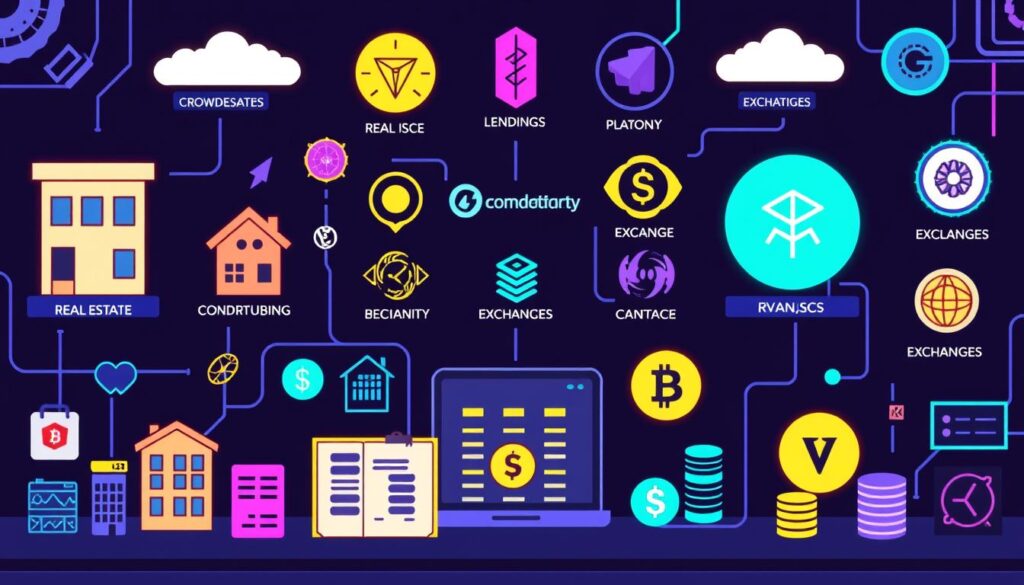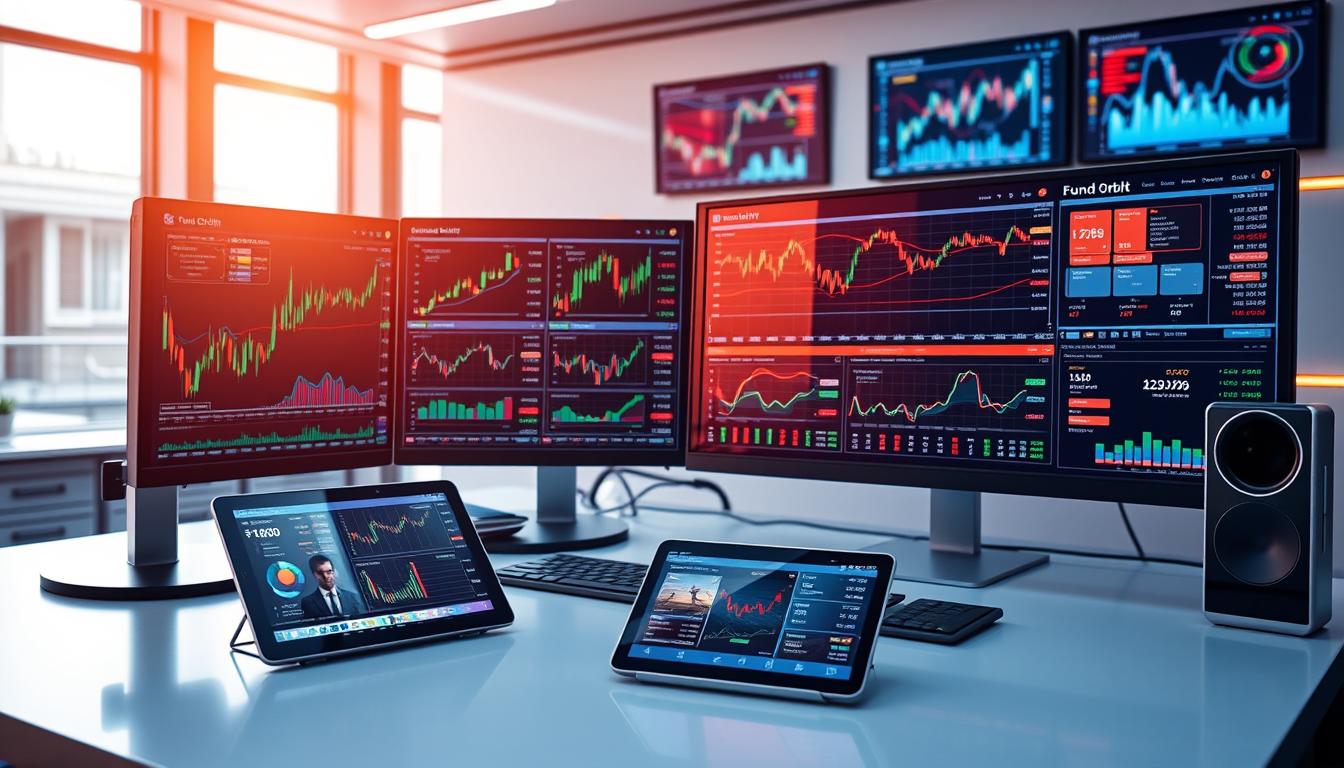The investment landscape is undergoing a significant transformation. The global DeFi market is projected to reach USD 26.81 billion by 2025, with expectations to soar to USD 2.55 trillion by 2037, growing at a CAGR of over 45.4%. This rapid growth indicates a substantial shift in investor preferences and the way people construct their portfolios.
As we navigate this evolving market, technological innovations are playing a crucial role. At CoWrit Technologies Inc, we’re helping investors stay ahead of the curve by leveraging AI Generative Applications and content solutions.
We’ll explore the major trends shaping the investment industry and highlight the emerging platforms that are democratizing investment opportunities.
Key Takeaways
- The DeFi market is expected to experience significant growth by 2025.
- Technological innovations are reshaping the investment landscape.
- AI-powered platforms are becoming increasingly important.
- CoWrit Technologies Inc is helping investors navigate this complex landscape.
- Emerging platforms are democratizing investment opportunities.
The Evolution of Investment Platforms in 2025
The investment landscape is undergoing a significant transformation in 2025, driven by technological advancements and changing investor preferences. As more businesses become interested in decentralized finance, selecting the appropriate platform becomes an increasingly important consideration. This is especially true if you are looking to maximize returns, ensure the safety of your assets, and dive headfirst into the decentralized economy.
How Technology is Reshaping the Investment Landscape
Technology is playing a pivotal role in reshaping the investment landscape. Advancements in AI, blockchain, and data analytics are enabling investment platforms to offer more sophisticated tools and personalized investment experiences. The growing adoption of mobile technologies is also driving platforms to become more mobile-friendly, catering to the preferences of younger investors.
Key Market Trends Driving Platform Innovation
Several key market trends are driving innovation in investment platforms. These include:
- The demand for greater transparency and lower fees, pushing platforms to become more cost-effective and open.
- Changing demographics, with Millennial and Gen Z investors seeking mobile-first, socially-conscious investing options.
- Regulatory changes around the world, influencing platform development with varying degrees of innovation and caution.
- Increasing competition in the investment platform space, leading to rapid feature development and specialization.
- Global economic factors, such as inflation concerns and interest rate fluctuations, influencing platform strategies and investment products.
- The growing availability of market data and analytics, enabling platforms to offer more sophisticated insights to investors.
These trends are collectively driving growth and adoption in the investment platform space, as they cater to the evolving needs of investors and the broader market.
AI-Powered Investment Platforms Leading the Way

As we step into 2025, AI-powered investment platforms are at the forefront of innovation. The integration of Artificial Intelligence (AI) in investment platforms has revolutionized the way investments are managed and executed. AI-driven quantitative trading platforms and next-generation robo-advisors are leading this change.
Next-Generation Robo Advisors
Next-generation robo-advisors are redefining investment management by leveraging AI to offer personalized investment advice. These platforms use complex algorithms to analyze an individual’s financial goals, risk tolerance, and investment horizon to provide tailored investment strategies. By doing so, they make investment management more accessible and affordable for a broader range of investors.
The use of AI in robo-advisors enables them to continuously learn and adapt to market conditions, thereby optimizing investment strategies and potentially improving returns. Moreover, these platforms provide a user-friendly interface, making it easier for retail investors to navigate and manage their investments.
AI-Driven Quantitative Trading Platforms
AI-driven quantitative trading platforms are transforming the landscape of trading by processing vast amounts of data to identify trading opportunities that may not be apparent to human traders. These platforms utilize advanced market analysis and pattern recognition techniques to detect inefficiencies and anomalies in the market.
By employing AI technologies such as deep learning, reinforcement learning, and natural language processing, these platforms can analyze both structured and unstructured data to make informed trading decisions. This not only enhances performance but also helps in managing risk more effectively.
Furthermore, AI-driven quantitative trading platforms are becoming increasingly accessible to retail investors, offering them the benefits of sophisticated trading strategies without the need for extensive technical knowledge.
Top DeFi Platforms Revolutionizing Finance in 2025
As we look to 2025, the DeFi sector is poised to revolutionize finance with innovative platforms. The DeFi landscape is becoming increasingly attractive to institutional investors due to its high yields and diversification opportunities.

Aave: The Leading Lending Protocol
Aave continues to be a dominant force in the DeFi lending space, offering innovative lending solutions and attractive yields for liquidity providers. Its development has been focused on improving security and expanding its services to new markets.
Uniswap: Decentralized Trading Reimagined
Uniswap remains at the forefront of decentralized trading, providing a platform for seamless token swaps and liquidity provision. Its innovation in automated market-making has been a key driver of its success.
Lido: Staking Solutions for the Future
Lido is revolutionizing staking in the DeFi space by offering secure and liquid staking solutions. Its development has focused on making staking more accessible and reducing associated risks.
Emerging DeFi Platforms to Watch
Several emerging DeFi platforms are gaining traction in 2025, offering novel financial services and improved user experiences. These platforms are addressing common challenges in the DeFi space, such as security vulnerabilities and complex user interfaces.
ESG-Focused Investment Platforms

As we move into 2025, the investment landscape is witnessing a significant shift towards ESG-focused investment platforms. These platforms are designed to cater to the growing demand for sustainable and responsible investments.
Sustainable Investing Through Digital Platforms
The rise of digital platforms has made it easier for investors to incorporate Environmental, Social, and Governance (ESG) factors into their investment decisions. These platforms offer a range of ESG-themed investments, allowing investors to align their portfolios with their values.
With a growing asset base in ESG ETFs, surpassing $97 billion at the close of 2022, it’s clear that sustainable investing is gaining traction. The number of sustainable ETFs in the United States has also seen a significant increase, with over 295 funds available as of mid-2023.
Top ESG ETF Platforms for Conscious Investors
Leading ESG ETF platforms are offering innovative products that cater to the diverse needs of conscious investors. These platforms provide various ESG screening methodologies, from exclusionary approaches to inclusionary strategies that focus on sustainability leaders.
Some of the key features to look out for in these platforms include transparent fees, robust risk management strategies, and a clear strategy for achieving returns while adhering to ESG principles. As the sector continues to evolve, we can expect to see more specialized ETFs targeting specific sustainability goals, such as renewable energy and carbon reduction.
Social and Copy Trading Platforms for the New Generation
Social and copy trading platforms are revolutionizing the way the new generation approaches investing in 2025. These platforms are changing the investment landscape by making it more accessible and social.

How Gen Z is Reshaping Social Trading
Gen Z is primarily using social media and internet searches to learn about investments, according to FINRA data. Nearly half of Gen Zers use social media to learn about investments, with YouTube being the number-one resource. This shift is driving the popularity of social and copy trading platforms.
These platforms are leveraging AI and machine learning to match investors with suitable traders to follow, based on risk tolerance and investment goals. This personalized approach is making it easier for new investors to enter the market.
Leading Copy Trading Platforms of 2025
We’re seeing a rise in copy trading platforms that offer unique features and performance metrics. These platforms are expanding beyond traditional assets to include crypto and other alternative investments. They are also implementing risk management tools to protect followers from excessive losses.
The compensation models vary, with some platforms charging fees based on performance, aligning the interests of lead traders with their followers. Successful trading strategies are being showcased, and these platforms are creating new career opportunities for skilled traders.
Alternative Investment Platforms Gaining Traction

In the evolving world of finance, alternative investment platforms are emerging as a key player. We’re seeing a significant shift in how investors approach the market, with alternative investments becoming increasingly attractive.
Alternative investment platforms offer a diverse range of assets, from private equity and debt investments to art and collectibles. These platforms are making it easier for investors to access new opportunities and diversify their portfolios.
Platforms for Private Equity and Debt Investments
Private equity and debt investments are becoming more accessible through digital platforms. These platforms connect investors with opportunities that were previously reserved for institutional investors or high-net-worth individuals.
By leveraging technology, these platforms reduce the risk associated with such investments and provide a more transparent market. Investors can now participate in the private equity and debt sector with greater ease and confidence.
Art and Collectibles Investment Platforms
Investing in art and collectibles is gaining popularity as a way to diversify investment portfolios. Platforms like Masterworks and Freeport are leading the way in fractional art ownership, allowing investors to buy shares in valuable art pieces.
These platforms use blockchain technology to ensure the transaction security and price transparency. They also provide a secondary market for art, improving asset liquidity and making it easier for investors to buy and sell shares.
Fractional Real Estate Investment Platforms
With the advent of fractional real estate investment platforms, the barrier to entry for real estate investing has significantly lowered. These platforms allow multiple investors to pool their funds to invest in a property, making it possible to own a fraction of a property rather than having to buy it outright.

Residential Property Investment Platforms
Residential property investment platforms have made it easier for individuals to invest in single-family homes, multi-family apartments, and other residential properties. For instance, Fundrise, one of the pioneers in this space, has democratized access to real estate investing with a portfolio worth over $7 billion. Investors can benefit from rental income and potential long-term appreciation in property value.
The returns on residential property investments have varied over the years, with 2021 being a particularly strong year, yielding nearly a 23% annual return. While returns have been modest since then, they have outperformed some traditional REITs.
Commercial Real Estate Fractional Platforms
Commercial real estate fractional platforms are expanding access to office buildings, retail centers, and industrial properties, assets that were once the exclusive domain of institutional investors. These platforms utilize technology to reduce minimum investment thresholds, streamline due diligence, and enhance transparency into property performance.
By investing in commercial real estate through these platforms, investors can diversify their portfolios and potentially benefit from both income generation and long-term value appreciation. Some platforms offer monthly distributions, while others focus on longer-term growth.
Global Market Access Platforms
Global market access platforms are revolutionizing the way we invest by providing unprecedented access to international markets. These platforms are bridging the gap between investors and global opportunities, enabling diversification and potentially higher returns.

Platforms Specializing in Asian Markets
Asian markets have shown remarkable growth in recent years. For instance, Japan’s Nikkei 225 surged nearly 25% by mid-2023, and India’s MSCI index outperformed China’s, rising 7% year-over-year as of October 2023. Platforms specializing in Asian markets are capitalizing on this trend, offering investors access to these high-growth economies.
Investors are taking notice of the potential in these markets, with notable investors like Warren Buffett increasing their investments in Japanese stocks. The growth in foreign direct investments in India, totaling over $919 billion between April 2000 and March 2023, further underscores the region’s attractiveness.
Emerging Market Investment Platforms
Emerging market investment platforms are opening up new opportunities for portfolio diversification by providing access to markets in Latin America, Africa, and Southeast Asia. These platforms address unique challenges such as political risk and currency volatility by offering specialized research and analysis, helping investors navigate complex markets.
They offer a range of investment vehicles, including direct equity investments, ETFs, mutual funds, and structured products focused on emerging markets. By facilitating impact investing, these platforms allow investors to support economic development while seeking financial returns, making them an attractive option for those looking to make a positive impact alongside their investments.
Choosing the Right Investment Platform: Key Considerations
The investment landscape is evolving rapidly, and choosing the right platform requires careful consideration of several factors. As we explore the various options available in 2025, it’s essential to evaluate the key features that distinguish one platform from another.
Security Features to Look For
When selecting an investment platform, security is paramount. Users expect robust protection for their investments and personal data. Top platforms employ advanced security measures, including multi-factor authentication, encryption, and regular security audits. These features help safeguard users’ accounts and transactions, providing peace of mind in an increasingly digital world.
Some platforms also offer additional security features such as insurance on investments or segregated accounts to further protect users’ assets. When evaluating a platform’s security, it’s crucial to look beyond the basics and understand the comprehensive security framework in place.
User Experience Considerations
The user experience is a critical factor in choosing an investment platform. Intuitive interfaces and streamlined processes can significantly enhance the investing experience, making it easier for users to navigate and manage their investments. Platforms that offer mobile apps, real-time market data, and customizable dashboards tend to provide a more satisfying user experience.
Moreover, educational resources and responsive customer support can greatly benefit new investors or those looking to expand their knowledge. By prioritizing user experience, platforms can empower investors to make more informed decisions and achieve their financial goals.
Fee Structures and Transparency
Understanding the fee structure of an investment platform is vital for investors. DeFi platforms, for instance, eliminate intermediaries like banks or brokers, significantly reducing transaction fees. This is particularly advantageous for cross-border transactions where traditional fees can be high. Smart contracts that are automated help make processes like lending, borrowing, and trading more efficient, cutting down on the costs and time typically involved in these activities.
Let’s examine the various fee structures employed by investment platforms in 2025:
| Fee Structure | Description | Typical Costs |
|---|---|---|
| Commission-based | Fees charged per transaction | $5-$20 per trade |
| Subscription Services | Monthly or annual fees for premium features | $10-$50 per month |
| Asset-based Fees | Fees based on total assets under management | 0.1%-1% annually |
When evaluating fee structures, it’s essential to consider not only the explicit costs but also hidden costs such as spread markups, payment for order flow, and currency conversion fees. By understanding the total cost of investing, users can make more informed decisions about which platform best suits their needs.

Conclusion
The investment platform space is undergoing a significant transformation in 2025, driven by advancements in AI, DeFi, and other cutting-edge technologies. As we’ve explored, top DeFi platforms are revolutionizing finance, while AI-powered platforms are enhancing investment decisions.
These trends have significant implications for various types of investors. Beginners can leverage user-friendly platforms to start their investment journey, while sophisticated traders can utilize advanced features to optimize their strategies. To navigate this landscape effectively, investors must stay informed about evolving platform features and capabilities.
When selecting an investment platform, consider factors such as security, user experience, and fee structures. As the investment technology landscape continues to evolve, we can expect further AI integration, expanded blockchain applications, and new asset classes. To stay ahead of these trends, investors must prioritize education and continuous learning.
At CoWrit Technologies Inc, our AI Generative Applications, content writing services, and digital marketing solutions can help investors stay informed and adapt to the changing landscape. For more information, feel free to reach out to us on WhatsApp at +44-7822010953.


